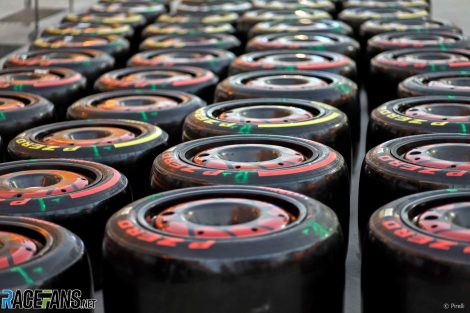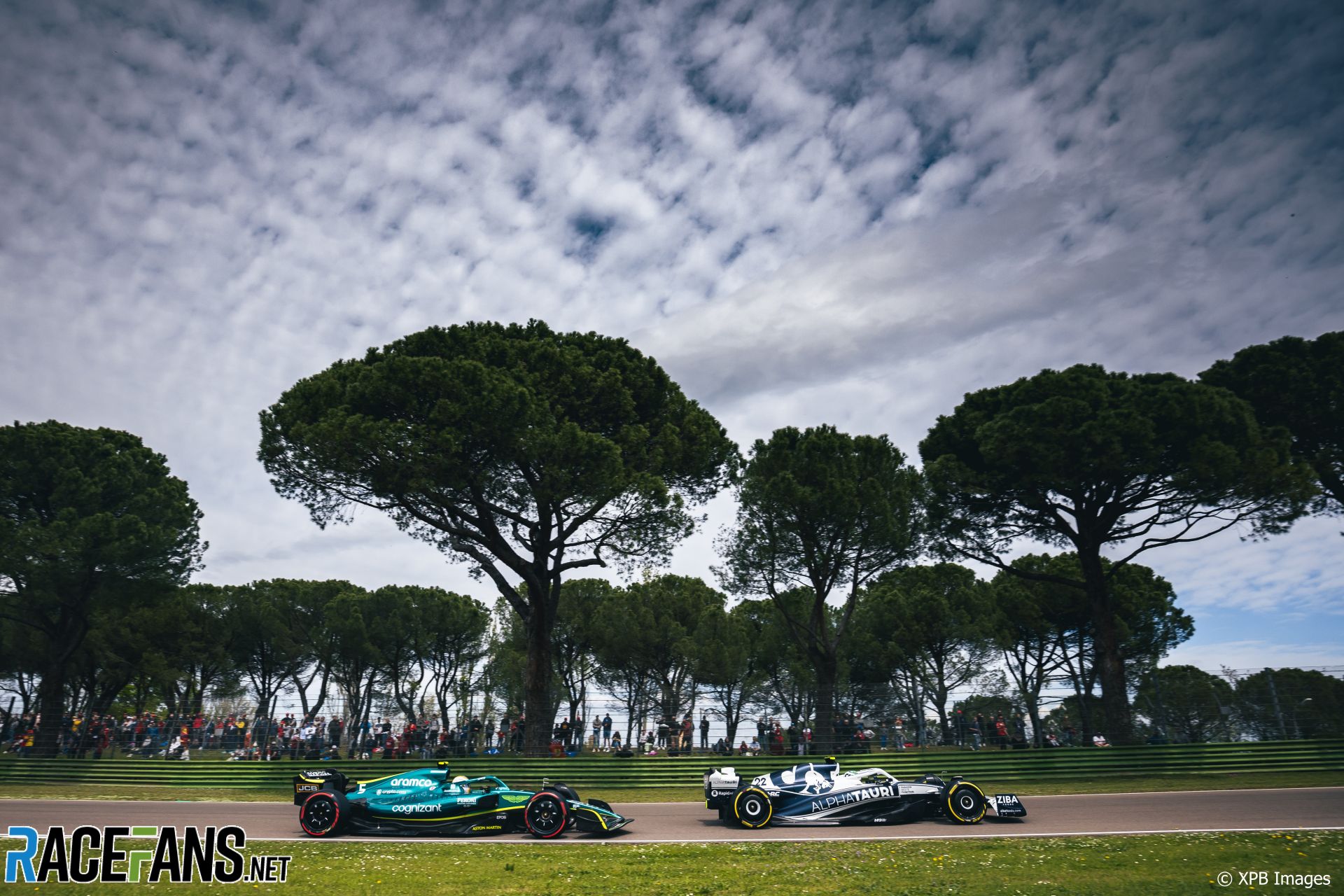Formula 1 has played around with several rules and features of a race weekend during the first five rounds of 2023, and another change will debut at the Emilia-Romagna Grand Prix.
This weekend will be the first ‘Alternative Tyre Allocation’ event. Drivers will only be allowed to use 11 sets of slick tyres rather than the usual limit of 13 at rounds that do not feature a sprint race or evaluation tyre compounds.Each driver can use three sets of the designated hard compound, four sets of the medium and four sets of the soft. That is half the number of soft tyres available on a standard weekend, and one more set each of the hard and the medium.
Pirelli has nominated its three softest slick compounds for use at Imola, meaning the C3, C4 and C5 tyres will be available, which is one stage softer than the teams had last year.
The intermediate and wet tyre allocation remains unchanged, with four sets of the former and three of the latter for the weekend. However Pirelli is bringing a new specification of wet weather tyre this weekend, and the weather forecast indicates teams are likely to need them.
Pirelli’s motorsport director Mario Isola said the changes are “both aimed at improving the environmental sustainability of our sport.”
Advert | Become a RaceFans supporter and
On top of the restriction on how many tyres can be used, drivers also have new limits on when they are allowed to use them.

“This means a reduction – from 13 to 11 – of the sets of dry tyres that each driver has available for the entire event, therefore decreasing the environmental impact generated by the production and transport of the tyres.”
The introduction of the new wet weather tyre this weekend is also part of a drive to reduce F1’s environmental impact.
“Starting from this grand prix a new compound of full wet tyre will be introduced which will not require the use of tyre warmers beforehand. Track tests have shown even better performance than the previous Cinturato Blue full wet, even without the electric heating of the tyre. The result of studies carried out by Pirelli, it is the first concrete step towards the use of dry tyres without preheating.”
While the new wet compound is designed to bypass the need for heated tyre warmers, before it becomes a planned regulatory requirement for 2024, teams will still be free to use them at Imola and the cool conditions that are forecast would make that the more sensible strategy. Having the softer slick compounds available in cold conditions will make tyre warm-up crucial in the dry too.
Advert | Become a RaceFans supporter and
Should any of the segments of qualifying be declared wet, then the rule determining which compound has to be used is dropped and drivers are free to choose from any of the slick or grooved options.
In total each driver will have seven sets of tyres to choose from for the race, which will have to include the C3s and C4s. They will need to return one set of tyres to Pirelli after both Friday practice sessions (unless a session is wet) and then return two sets following third practice on Saturday (three sets if Friday is wet).
Should it remain dry, every driver who qualifies in the top ten is guaranteed to go into the race having tried all three slick compounds on the track. That could provide a strategic advantage, but may prompt drivers to do less running in practice to save tyres for later in the weekend – particularly with fewer sets of the soft compound than usual.
Although the Emilia-Romagna GP is Pirelli’s home race, it still has to ship in its race tyres to Italy due to its manufacturing facilities being in Romania and Turkey, which is why restricting tyre usage for Imola will lead to a reduced environmental footprint. The potential gains at further-flung races are even greater.
Become a RaceFans Supporter
RaceFans is run thanks in part to the generous support of its readers. By contributing £1 per month or £12 per year (or the same in whichever currency you use) you can help cover the costs of creating, hosting and developing RaceFans today and in the future.
Become a RaceFans Supporter today and browse the site ad-free. Sign up or find out more via the links below:
2023 Emilia-Romagna Grand Prix
- The first Formula 1 race cancelled by climate change is unlikely to be the last
- Upgrades delayed and relief for Gasly: How Imola’s cancellation affects the competition
- Imola circuit to refund ticket holders for cancelled grand prix
- “This morning it was obviously much worse”: Why F1 had to call off its Imola race
- Imola GP promoter expects lost race will lead to one-year contract extension





Jere (@jerejj)
16th May 2023, 16:25
”Should any of the segments of qualifying be declared wet, then the rule determining which compound has to be used is dropped and drivers are free to choose from any of the slick or grooved options.”
– Except wet conditions would automatically mean at least intermediate, but generally, I hope the new wet tyre proves more usable than the previous version.
RandomMallard
16th May 2023, 16:28
@jerejj I would assume this probably covers a wet-to-dry scenario, where they reach the crossover point during qualifying and start to run slicks later on, in which case you would want to run the soft tyres as they’ll have the lowest operating temperature so will be easiest to heat up while still staying on the track.
Bullfrog (@bullfrog)
16th May 2023, 16:39
Use locally-made tyres. Can’t be any worse.
Darryn Smith (@darryn)
16th May 2023, 18:51
Will they be vegan and gluten-free though?
Coventry Climax
17th May 2023, 13:08
Actually, and despite @darryn ‘s fun remark, that’s not a bad idea at all. Saves the global transport and associated emissions, supports the inclusivity idea and brings back the tyre competition.
Won’t happen though: F1’s and Liberty’s concepts of both ‘green’ and ‘inclusivity’ are not based on ideology, but on what profits them the most. I know, half the world seems to think that the same thing, but it isn’t.
Darryn Smith (@darryn)
16th May 2023, 18:50
Green tires? Just make one of the compounds last the entire race and get softer from there. Get rid of the forced strategy rule.
Rhys Lloyd (@justrhysism)
17th May 2023, 4:25
Wets have…
I’m sure it’s technically correct, but that bar isn’t particularly high, is it? Choice of words are suggestive that the current wets are actually good.
Biskit Boy (@sean-p-newmanlive-co-uk)
17th May 2023, 7:29
I’m, so with you on this one. Where would Ocon have finished at Baku had he not pitted on the last lap? Not sure but it just shows the sort of strategic variety you could have with such a rule change.
Now if I can get a bit silly for a moment, truly green tires might last multiple races…
Biskit Boy (@sean-p-newmanlive-co-uk)
17th May 2023, 7:30
oops replied to Rhys instead of Darryn.
Coventry Climax
17th May 2023, 13:11
Biskit Boy might have misplaced his reply, but this is exactly what my thoughts were, reading those lines.
So yes, I am with you on this one.
Dan Rooke (@geekzilla9000)
17th May 2023, 9:07
If they are promoting green tyres then a single set that lasts an entire a race is much greener, there’d be far less to manufacture and transport around the world. Also, a tyre that degrades less will throw out less pollutants. It’s only recently that the impact of tyre particles on the environment has been really studied and they’re pretty awful things in terms of pollutants.
Coventry Climax
17th May 2023, 13:31
I remember studies about that as far back as somewhere around the ’80’s. But maybe that’s your definition of ‘recently’. The outcome wasn’t very favourable back then either. Just leave it to the automotive industry to have these more recent studies end up on the bottom in the bottom drawer as well.
Same happened with the electric car. (source: wikipedia)
Electric cars were already race as far back as the 1890’s, with some races even across the american continent.